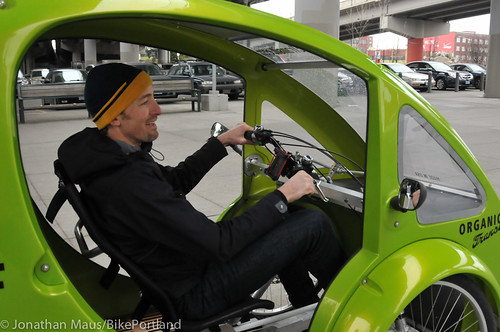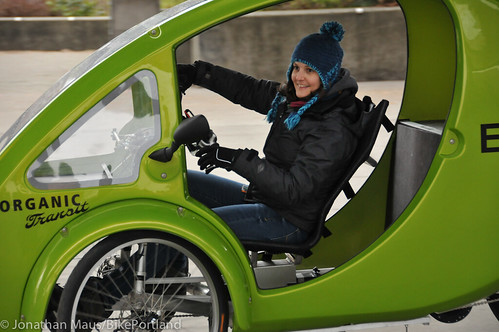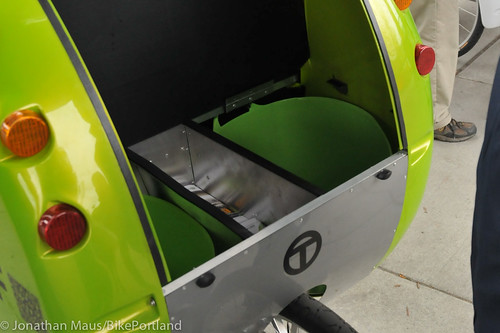
(Photos by J. Maus/BikePortland)
It’s not a bike and it’s not a car, but the ELF trike is quickly finding fans in Portland who are looking for something in between.
Organic Transit, the North Carolina-based company that makes the ELF solar and pedal-powered trike, just wrapped up three busy days of test rides (two days in Troutdale and one day in Portland). I dropped by the test ride event Tuesday on the eastbank of the Willamette River near the Hawthorne Bridge to take a closer look, meet the company’s founder and CEO Rob Cotter, and get people’s impressions of these interesting vehicles.
48-year old Chris Streight was one of the 50 or so people who signed up to get behind the handlebars of an ELF. With his work commute being 10 miles each way, Streight said taking his preferred vehicle — a bicycle — five days a week just isn’t doable. He was curious if the ELF would be a good way to tackle his commute on the days he doesn’t bike.
“In America, 90% of car traffic is just one person [behind the wheel] and half of all trips are two miles or less, yet bicycles are seen as toys. That’s our downfall.”
— Rob Cotter, Organic Transit CEO and founder
For David B., a 74-year old man who walks with a cane, it was the solar panel on top of the trike that brought him down for a test ride. “I’m interested in anything having to do with solar efficiency,” he told me. While David has trouble walking, he’s a frequent bike rider. He enjoyed his test ride in the ELF, but his main complaint was that it was difficult for him to get in and out of with his stiff legs. “But once you’re inside,” he added, “it’s fun and easy to drive.” “I could see this replacing my car, but not my bike,” he added.
Watching over the test riders was Organic Transit CEO and Founder Rob Cotter. Cotter has deep roots in the world of human and solar-powered vehicles. Mix in his former marketing company with clients like Mercedes Benz, IBM, Mattel, and Disney, and it becomes clear that Cotter isn’t just some garage innovator peddling a crazy idea. To him, the ELF isn’t just a new product, it’s the start of a revolution. Actually, if all goes well, it’s the start of two revolutions.
Cotter talks about saving the planet with as much fervor as he talks of saving American manufacturing.
“In America, 90% of car traffic is just one person and half of all trips are two miles or less, yet bicycles are seen as toys. That’s our downfall.” Reflecting on his relatively new company, Cotter said that the U.S. is probably the “worst place in the world” to launch a solar and pedal-powered trike. But in addition to helping cut down auto emissions, Cotter sees the ELF as something that can re-ignite America’s demand for blue-collar, industrial labor. Similar to Henry Ford, Cotter’s vision is factories across the U.S. full of wage-earners putting together ELF trikes in an assembly line.
As he showed me around the ELF, Cotter pointed out how the entire design was made to be simple so that it doesn’t take high-skilled welders and machine operators to make them. The shell (“Which acts like a helmet,” Cotter says) is made from pre-formed pieces that are easily riveted together. The trunk consists of two plastic buckets. The running boards on each side of the seat are bamboo dish-drying racks. The interior walls are made from Coroplast (corrugated plastic). The main spine of the chassis slides on pre-cut square aluminum tubes.
Michael Nover, formerly president of Kinesis USA, a frame-building company that used to be based in Portland, is now helping Cotter set up a local manufacturing and retail operation (it would be their first outside of Durham). “The majority of cost in a bicycle frame is in the welding and bending of tubes,” he shared. “Compared to what we used to do at Kinesis, the ELF is radically simpler. We can go to almost any fabrication shop to get these made.”
Cotter sees the ELF changing from one region to the next as it adapts to local topography and tastes. The business plan is also based on setting up many small building operations instead of centralized factories. This is because at 150 pounds, shipping ELFs takes away from the eco-friendly ethic Cotter believes in and adds to its $5,000 price tag.
So. How does it ride? I stepped inside and pedaled around the Esplanade to find out.
It’s certainly not a bike. Or even a recumbent. It feels clunkier than either of those. But that’s to be expected when operating a vehicle that weighs 150 pounds, is fully wrapped in a plastic body, and requires you to turn two wheels at the same time. The actual pedaling motion felt very intuitive and the steering system worked smoothly and predictably. I could stop on a dime thanks to the disc brakes, and getting back up to speed was made relatively easy due to the twisting of an internal Nuvinci hub in one hand and the the throttle for the electric motor in the other.
Adding to the ELFs stature as a road-worthy vehicle (both mentally and physically) is the heavy-duty horn (operated by a button on the handlebars), right and left-side mirrors, and the car-like headlights and taillights.
During my short test ride, I tried a few very sharp turns and the ELF remained stable. I also tried to turnaround on the Esplanade path and quickly realized that the turning radius is pretty wide. This could get folks into trouble if they expect to quickly flip a u-turn like they normally would on a bike. (It’s also worth noting that the recommended method to quickly turn 180-degrees, or go in reverse for that matter, is to get out and lift up the rear end.)
My ride in the ELF left me with more questions than I arrived with: What would it be like to share a lane with other vehicles on a major arterial? How long before these hit the road will Oregon law catch up and classify them as something other than a bicycle? How easy would it be to climb up a hill to north Portland if the battery dies? Would the solar panel be a reliable source of re-charging power?
At this point, Cotter is fine with all the questions his creation raises. When I asked if he considers it more closely related to a bicycle or a car (“Is this event a test ride or a test drive,” I asked), he happily declined to pigeon-hole it.
“There’s a lot of space [in the market] between a bike and a car, and that’s where we intend to be.”
Scroll down for more photos and notes from the test ride…

— Learn more about the ELF at OrganicTransit.com













